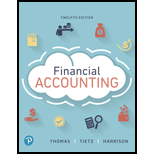
Financial Accounting (12th Edition) (What's New in Accounting)
12th Edition
ISBN: 9780134725987
Author: C. William Thomas, Wendy M. Tietz, Walter T. Harrison Jr.
Publisher: PEARSON
expand_more
expand_more
format_list_bulleted
Question
Chapter 9, Problem 10QC
To determine
To identify: The formula used to calculate the amount of bond discount amortized each for interest period.
Expert Solution & Answer
Want to see the full answer?
Check out a sample textbook solution
Students have asked these similar questions
Can you solve this general accounting problem with appropriate steps and explanations?
I am looking for the correct answer to this general accounting question with appropriate explanations.
Solve this issue accounting
Chapter 9 Solutions
Financial Accounting (12th Edition) (What's New in Accounting)
Ch. 9 - Brownlee Company issued 525,000, 8%, six-year...Ch. 9 - A bond with a face value of 250,000 and a quoted...Ch. 9 - Mission Furniture issued 500,000 in bonds payable...Ch. 9 - Bonds with an 8% stated interest rate were issued...Ch. 9 - Brimfest Corporation issued 2,400,000, 10-year, 6%...Ch. 9 - The Discount on Bonds Payable account a.is an...Ch. 9 - The discount on a bond payable becomes...Ch. 9 - The carrying value of Bonds Payable equals a.Bonds...Ch. 9 - Prob. 9QCCh. 9 - Prob. 10QC
Ch. 9 - Prob. 11QCCh. 9 - When a company retires bonds early, the gain or...Ch. 9 - Which type of lease will not increase a companys...Ch. 9 - Prob. 14QCCh. 9 - The debt ratio is calculated by dividing: a. total...Ch. 9 - Prob. 16QCCh. 9 - Prob. 17QCCh. 9 - Prob. 9.1ECCh. 9 - Prob. 9.1SCh. 9 - (Learning Objective 1: Determine bond prices at...Ch. 9 - (Learning Objective 1: Journalize basic bond...Ch. 9 - Prob. 9.4SCh. 9 - Prob. 9.5SCh. 9 - Prob. 9.6SCh. 9 - Prob. 9.7SCh. 9 - Prob. 9.8SCh. 9 - (Learning Objective 2: Account for bonds payable...Ch. 9 - Prob. 9.10SCh. 9 - LO 4,5 (Learning Objectives 4, 5: Deferred income...Ch. 9 - LO 5 (Learning Objective 5: Compute and evaluate...Ch. 9 - LO 5 (Learning Objective 5: Calculate the leverage...Ch. 9 - LO 6 (Learning Objective 6: Report liabilities)...Ch. 9 - (Learning Objective 1: Issue bonds payable...Ch. 9 - Prob. 9.16AECh. 9 - Prob. 9.17AECh. 9 - LO 2 (Learning Objective 2: Issue bonds payable...Ch. 9 - Prob. 9.19AECh. 9 - LO 4 (Learning Objective 4: Account for deferred...Ch. 9 - (Learning Objective 5: Evaluate debt-paying...Ch. 9 - LO 4, 5 (Learning Objectives 4, 5: Analyze current...Ch. 9 - Prob. 9.23AECh. 9 - (Learning Objective 1: Issue bonds payable...Ch. 9 - Prob. 9.25BECh. 9 - Prob. 9.26BECh. 9 - Prob. 9.27BECh. 9 - Prob. 9.28BECh. 9 - LO 4 (Learning Objective 4: Account for deferred...Ch. 9 - Prob. 9.30BECh. 9 - Prob. 9.31BECh. 9 - Prob. 9.32BECh. 9 - A bond with a face amount of 12,000 has a current...Ch. 9 - The carrying value on bonds equals Bends Payable...Ch. 9 - Prob. 9.35QCh. 9 - Prob. 9.36QCh. 9 - Prob. 9.37QCh. 9 - Prob. 9.38QCh. 9 - Prob. 9.39QCh. 9 - Prob. 9.40QCh. 9 - Prob. 9.41QCh. 9 - Prob. 9.42QCh. 9 - Prob. 9.43QCh. 9 - Prob. 9.44QCh. 9 - Prob. 9.45QCh. 9 - Prob. 9.46QCh. 9 - Prob. 9.47QCh. 9 - Prob. 9.48QCh. 9 - Prob. 9.49QCh. 9 - Prob. 9.50APCh. 9 - (Learning Objectives 1, 6: Issue bonds at a...Ch. 9 - Prob. 9.52APCh. 9 - Prob. 9.53APCh. 9 - (Learning Objectives 2, 3, 6: Issue convertible...Ch. 9 - Prob. 9.55APCh. 9 - Prob. 9.56BPCh. 9 - Prob. 9.57BPCh. 9 - Prob. 9.58BPCh. 9 - Prob. 9.59BPCh. 9 - (Learning Objectives 2, 3, 6: Issue convertible...Ch. 9 - (Learning Objectives 4, 5, 6: Report liabilities...Ch. 9 - Prob. 9.62CEPCh. 9 - Prob. 9.63CEPCh. 9 - Prob. 9.64SCCh. 9 - (Learning Objective 5: Explore an actual...Ch. 9 - Prob. 1FF
Knowledge Booster
Similar questions
- I need help completing my discussion post. Consumer laws are needed to protect buyers from being exploited when purchasing goods and services and to regulate the transactions between consumers and sellers. The federal agency that creates and enforces consumer protection law is the Federal Trade Commission. What purpose does the Federal Trade Commission serve and why must business owners be educated on Federal Trade Commission practices? Considering 1 of the following sections of the Federal Trade Commission Act: Deceptive Advertising Labeling and Packaging Laws Credit Protection Regarding the section you chose, provide an example of when a deceptive practice has been used in business and the consequence(s) for the deceptive practice.arrow_forwardPlease provide the accurate answer to this general accounting problem using appropriate methods.arrow_forwardWhat is the annual depreciation expense?arrow_forward
- Accounting solutionsarrow_forwardSubject = General Accountarrow_forwardInnovative Products operations for the year produced a margin of safety (M/S) ratio of 30% and a contribution margin (C/M) ratio of 60%. The company's fixed costs amounted to $75,000. Compute and interpret the following: Contribution Provide answerarrow_forward
arrow_back_ios
SEE MORE QUESTIONS
arrow_forward_ios
Recommended textbooks for you
- Principles of Accounting Volume 1AccountingISBN:9781947172685Author:OpenStaxPublisher:OpenStax College
 Intermediate Accounting: Reporting And AnalysisAccountingISBN:9781337788281Author:James M. Wahlen, Jefferson P. Jones, Donald PagachPublisher:Cengage Learning
Intermediate Accounting: Reporting And AnalysisAccountingISBN:9781337788281Author:James M. Wahlen, Jefferson P. Jones, Donald PagachPublisher:Cengage Learning College Accounting, Chapters 1-27AccountingISBN:9781337794756Author:HEINTZ, James A.Publisher:Cengage Learning,
College Accounting, Chapters 1-27AccountingISBN:9781337794756Author:HEINTZ, James A.Publisher:Cengage Learning,

Principles of Accounting Volume 1
Accounting
ISBN:9781947172685
Author:OpenStax
Publisher:OpenStax College

Intermediate Accounting: Reporting And Analysis
Accounting
ISBN:9781337788281
Author:James M. Wahlen, Jefferson P. Jones, Donald Pagach
Publisher:Cengage Learning

College Accounting, Chapters 1-27
Accounting
ISBN:9781337794756
Author:HEINTZ, James A.
Publisher:Cengage Learning,
